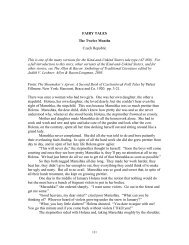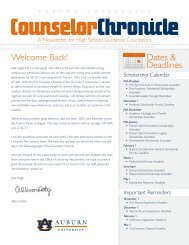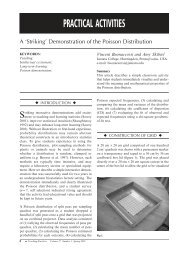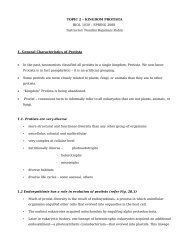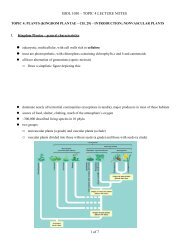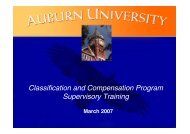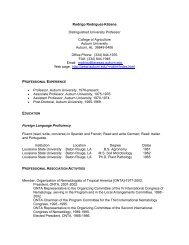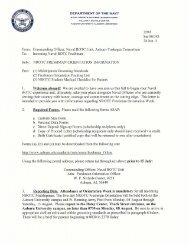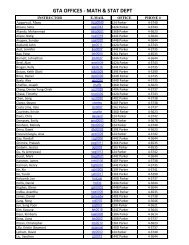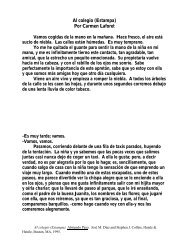COLLEGE OF SCIENCES AND MATHEMATICS - Auburn University
COLLEGE OF SCIENCES AND MATHEMATICS - Auburn University
COLLEGE OF SCIENCES AND MATHEMATICS - Auburn University
Create successful ePaper yourself
Turn your PDF publications into a flip-book with our unique Google optimized e-Paper software.
S<br />
pecial agent forensic<br />
scientist, Chuck Hardy<br />
(Biochemistry, ’95),<br />
knows he was destined to<br />
be an <strong>Auburn</strong> Tiger. Not<br />
only are his parents and<br />
most of his family <strong>Auburn</strong> graduates,<br />
but it was as a student that he<br />
was led to a career in the forensic<br />
sciences. As a senior, he attended a<br />
presentation by the Alabama Department<br />
of Forensic Sciences and<br />
was hooked. Th ough his path was<br />
a winding one following graduation,<br />
he found his way to a position with<br />
the Serology/DNA Unit of the Tennessee<br />
Bureau of Investigation (TBI).<br />
As a forensic scientist, Hardy inspects<br />
crime-scene, physical evidence,<br />
then chemically tests any questioned<br />
stains to determine if there are biological<br />
samples present. He takes the<br />
H<br />
o With COSAM!<br />
ow does one go from<br />
an undergraduate degree<br />
in Applied Physics to holding<br />
the position of City<br />
Manager for the City of<br />
<strong>Auburn</strong>? Ask Charlie Duggan (’90).<br />
As an undergraduate, he worked<br />
for the city of <strong>Auburn</strong> helping to organize<br />
the soccer league in the Parks<br />
and Recreation Department. Following<br />
graduation, he was off ered a full-time<br />
position as the Athletics Specialist.<br />
From there, Duggan held a variety<br />
of jobs for the City, including City<br />
Director of Special Programs, Deputy<br />
Director of Information Technology,<br />
and Assistant City Manager. By<br />
October 2006, aft er serving more than<br />
15 years, he was named City Manager.<br />
Despite his extensive, hands-on experience<br />
in city government, Duggan<br />
believes that much of what he learned<br />
as an undergraduate student in applied<br />
Photo courtesy of Chuck Hardy<br />
sample and extracts the DNA to create<br />
a unique profi le to be compared to the<br />
victim or suspect in a case. Hardy is<br />
a commissioned agent with the TBI,<br />
and is the team leader of one of fi ve<br />
Violent Crime Response teams, which<br />
provide assistance statewide. Additionally,<br />
Hardy participated in hazardous-materials<br />
training and is a part of<br />
the Terrorist Incident Response team.<br />
“I never had any plans to go anywhere<br />
but <strong>Auburn</strong>...I guess you could say<br />
I was destined to be a Tiger.”<br />
— Chuck Hardy<br />
physics has helped to shape his career.<br />
“One of the biggest things I learned<br />
that has helped me, is to focus on the<br />
basics. Like in research — you take a<br />
hypothesis, then test it and see how it<br />
comes out. It’s the same in life — you<br />
can’t know where you are going unless<br />
you know where you are,” Duggan said.<br />
Duggan also credits professors<br />
like Eugene Clothiaux and<br />
John Williams for providing a positive<br />
and inspiring example.<br />
“Th ey (the professors) really enjoyed what they<br />
were doing. I learned to wake up and look at the<br />
‘challenges’ of the day instead of the ‘problems.’”<br />
— Charlie Duggan<br />
A<br />
career with<br />
the International<br />
Atomic Energy<br />
Agency (IAEA)<br />
and a share of<br />
the 2005 Nobel<br />
Peace Prize were the last things<br />
John Oakberg (Mathematics,<br />
’69) saw in his future when<br />
he graduated from <strong>Auburn</strong>.<br />
With his mathematics degree<br />
and a Fortran course taken his<br />
senior year, Oakberg got a job<br />
with Union Carbide’s Nuclear<br />
Division. Aft er earning a<br />
master’s in computer science,<br />
he was invited to work developing<br />
soft ware for the IAEA in<br />
Vienna. He and his wife Linda<br />
(History, ’69) spent 18 months<br />
there, and upon returning to<br />
their hometown of Oak Ridge,<br />
TN, realized how much they<br />
enjoyed their life in Vienna.<br />
Oakberg pursued opportunities<br />
in the IAEA so they could<br />
return, and they did so with<br />
the expectation of a four-year<br />
stay. Twenty-fi ve years later,<br />
he is preparing for retirement<br />
and their return to Tennessee<br />
this fall, with memories of a<br />
successful international career.<br />
“As far away in my thoughts<br />
that I would spend so many<br />
years with a U.N. agency<br />
and live in Europe, was that<br />
I would ever be related to a<br />
Nobel Peace Prize, even as just<br />
one staff member among all<br />
of those at the IAEA,” he said.<br />
“It is an indescribable, overwhelming<br />
and awe-inspiring<br />
feeling, and an achievement<br />
of which we are very proud.”<br />
stay. Twenty-fi ve years later,<br />
“... that I would ever be related to a Nobel<br />
Peace Prize ... is an indescribable,<br />
overwhelming and awe-inspiring feeling ...”<br />
— John Oakberg<br />
G<br />
reg Ness<br />
(Biomedical Sciences,<br />
’01) is a<br />
fi rst-year associate<br />
in an Atlantabased<br />
law fi rm<br />
specializing in land use and<br />
environmental law. Ness<br />
coordinates environmental<br />
due diligence assessments and<br />
Photos courtesy of John Oakberg<br />
Photo courtesy of Greg Ness<br />
counsels clients on environmental liability and risk allocation.<br />
Aft er earning a degree in biomedical sciences, in addition<br />
to his Juris Doctorate, he obtained a master’s in molecular<br />
biology and a master’s in environmental law. He is admitted<br />
to practice in Georgia, Kentucky, Washington, D.C., several<br />
federal courts and the U.S. Patent and Trademark Offi ce.<br />
“I frequently call on concepts that I acquired from<br />
my COSAM classes to understand the nature of<br />
hazardous substances and their potential eff ects ...”<br />
— Greg Ness<br />
College of Sciences and Mathematics 12



